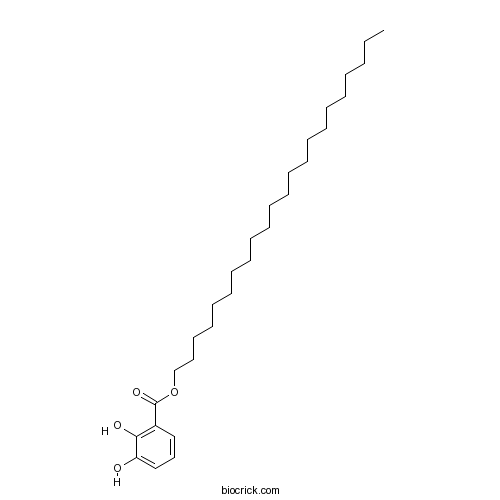Gentiside JCAS# 1238837-50-7 |

Quality Control & MSDS
3D structure
Package In Stock
Number of papers citing our products

| Cas No. | 1238837-50-7 | SDF | Download SDF |
| PubChem ID | 14177660 | Appearance | Powder |
| Formula | C29H50O4 | M.Wt | 462.71 |
| Type of Compound | Phenols | Storage | Desiccate at -20°C |
| Solubility | Soluble in Chloroform,Dichloromethane,Ethyl Acetate,DMSO,Acetone,etc. | ||
| Chemical Name | docosyl 2,3-dihydroxybenzoate | ||
| SMILES | CCCCCCCCCCCCCCCCCCCCCCOC(=O)C1=C(C(=CC=C1)O)O | ||
| Standard InChIKey | ZYHQORYZNVHDNT-UHFFFAOYSA-N | ||
| Standard InChI | InChI=1S/C29H50O4/c1-2-3-4-5-6-7-8-9-10-11-12-13-14-15-16-17-18-19-20-21-25-33-29(32)26-23-22-24-27(30)28(26)31/h22-24,30-31H,2-21,25H2,1H3 | ||
| General tips | For obtaining a higher solubility , please warm the tube at 37 ℃ and shake it in the ultrasonic bath for a while.Stock solution can be stored below -20℃ for several months. We recommend that you prepare and use the solution on the same day. However, if the test schedule requires, the stock solutions can be prepared in advance, and the stock solution must be sealed and stored below -20℃. In general, the stock solution can be kept for several months. Before use, we recommend that you leave the vial at room temperature for at least an hour before opening it. |
||
| About Packaging | 1. The packaging of the product may be reversed during transportation, cause the high purity compounds to adhere to the neck or cap of the vial.Take the vail out of its packaging and shake gently until the compounds fall to the bottom of the vial. 2. For liquid products, please centrifuge at 500xg to gather the liquid to the bottom of the vial. 3. Try to avoid loss or contamination during the experiment. |
||
| Shipping Condition | Packaging according to customer requirements(5mg, 10mg, 20mg and more). Ship via FedEx, DHL, UPS, EMS or other couriers with RT, or blue ice upon request. | ||
| Description | 1. Gentiside J is a potent inducer of neurite outgrowth on PC12 cells. |

Gentiside J Dilution Calculator

Gentiside J Molarity Calculator
| 1 mg | 5 mg | 10 mg | 20 mg | 25 mg | |
| 1 mM | 2.1612 mL | 10.8059 mL | 21.6118 mL | 43.2236 mL | 54.0295 mL |
| 5 mM | 0.4322 mL | 2.1612 mL | 4.3224 mL | 8.6447 mL | 10.8059 mL |
| 10 mM | 0.2161 mL | 1.0806 mL | 2.1612 mL | 4.3224 mL | 5.403 mL |
| 50 mM | 0.0432 mL | 0.2161 mL | 0.4322 mL | 0.8645 mL | 1.0806 mL |
| 100 mM | 0.0216 mL | 0.1081 mL | 0.2161 mL | 0.4322 mL | 0.5403 mL |
| * Note: If you are in the process of experiment, it's necessary to make the dilution ratios of the samples. The dilution data above is only for reference. Normally, it's can get a better solubility within lower of Concentrations. | |||||

Calcutta University

University of Minnesota

University of Maryland School of Medicine

University of Illinois at Chicago

The Ohio State University

University of Zurich

Harvard University

Colorado State University

Auburn University

Yale University

Worcester Polytechnic Institute

Washington State University

Stanford University

University of Leipzig

Universidade da Beira Interior

The Institute of Cancer Research

Heidelberg University

University of Amsterdam

University of Auckland

TsingHua University

The University of Michigan

Miami University

DRURY University

Jilin University

Fudan University

Wuhan University

Sun Yat-sen University

Universite de Paris

Deemed University

Auckland University

The University of Tokyo

Korea University
- PCA 4248
Catalog No.:BCC6699
CAS No.:123875-01-4
- UNC0321
Catalog No.:BCC4142
CAS No.:1238673-32-9
- Kazinol U
Catalog No.:BCN4720
CAS No.:1238116-48-7
- Hopeachinol B
Catalog No.:BCN3445
CAS No.:1238083-45-8
- Hydroxyevodiamine
Catalog No.:BCN2491
CAS No.:1238-43-3
- QNZ 46
Catalog No.:BCC6292
CAS No.:1237744-13-6
- ML 786 dihydrochloride
Catalog No.:BCC7997
CAS No.:1237536-18-3
- Escin IA
Catalog No.:BCN3862
CAS No.:123748-68-5
- Aucherine
Catalog No.:BCN2058
CAS No.:123715-12-8
- Acetyl-Calpastatin (184-210) (human)
Catalog No.:BCC2350
CAS No.:123714-50-1
- Moracin O
Catalog No.:BCN4004
CAS No.:123702-97-6
- Kuwanol C
Catalog No.:BCN3941
CAS No.:123702-94-3
- Cassiaside
Catalog No.:BCN2939
CAS No.:123914-49-8
- (R)-(+)-HA-966
Catalog No.:BCC6588
CAS No.:123931-04-4
- Hypocrellin B
Catalog No.:BCN3397
CAS No.:123940-54-5
- Topotecan
Catalog No.:BCC5646
CAS No.:123948-87-8
- Decane
Catalog No.:BCN8138
CAS No.:124-18-5
- Isoborneol
Catalog No.:BCN7158
CAS No.:124-76-5
- Picrotoxin
Catalog No.:BCC5705
CAS No.:124-87-8
- Oxycodone hydrochloride
Catalog No.:BCC6090
CAS No.:124-90-3
- Triamcinolone
Catalog No.:BCC4741
CAS No.:124-94-7
- 1beta,10beta-Epoxydesacetoxymatricarin
Catalog No.:BCN7307
CAS No.:124020-39-9
- Kobophenol A
Catalog No.:BCN3444
CAS No.:124027-58-3
- AZD3514
Catalog No.:BCC1070
CAS No.:1240299-33-5
Gentisides C-K: nine new neuritogenic compounds from the traditional Chinese medicine Gentiana rigescens Franch.[Pubmed:20813533]
Bioorg Med Chem. 2010 Oct 1;18(19):6995-7000.
Nine new alkyl 2,3-dihydroxybenzoates, gentisides C-K, were isolated from the traditional Chinese medicine Gentiana rigescens Franch. Their structures and stereochemistry were elucidated by spectroscopic methods, and comparison of the specific rotation with that of the gentiside B. These metabolites are additional members of the gentisides which belong to a novel class of neuritogenic compounds. They are structurally different from one another because they possess varying alkyl chain lengths, with or without an isobutyl or isopropyl group at the end of the alkyl chain. These compounds are potent inducers of neurite outgrowth on PC12 cells. The gentiside C possessing the shortest alkyl chain length exhibited the highest neuritogenic activity among all of the gentisides. Gentiside C showed a significant neuritogenic activity at 1 muM against PC12 cells comparable to that seen for the best nerve growth factor (NGF) concentration of 40 ng/mL. In addition, evident neuritogenic activity was observed in the cells when treated with gentiside C at a concentration as low as 0.03 muM. The structure-activity relationships within the gentisides A-K revealed that alkyl chain length is important for the activity, but structure diversity at the end of the alkyl chain is not.


